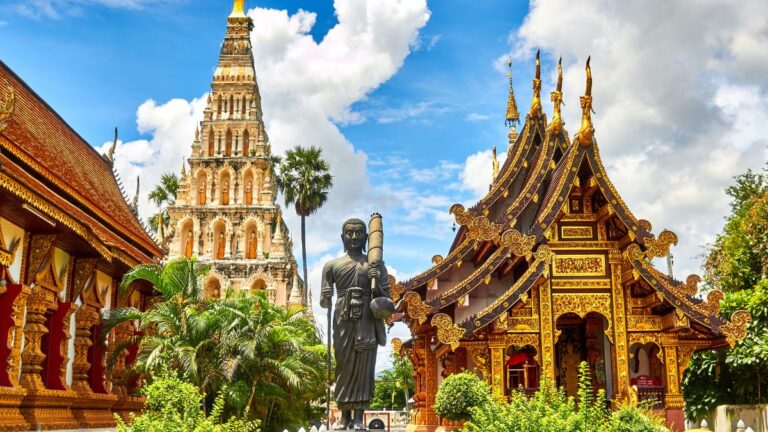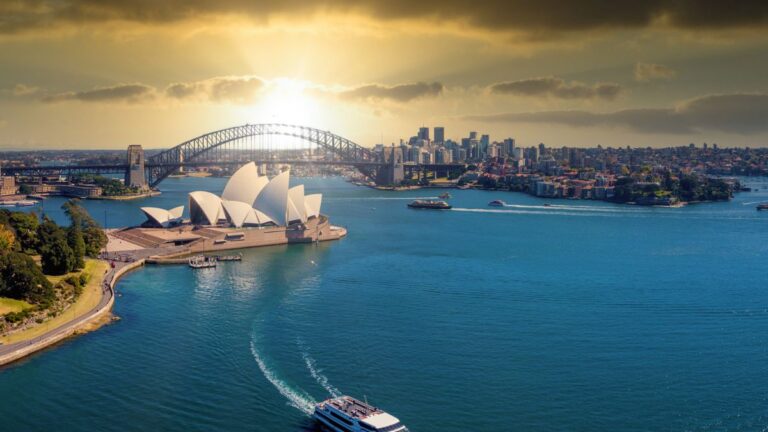Rome Travel Guide: Discovering the Eternal City’s Ancient Charms and Culinary Delights

As participants in Amazon Associates and other programs, we earn from qualifying purchases. This comes at no additional cost to you. For more details, see our Affiliate Disclosure.
Rome, known as the Eternal City, invites travelers to step back in time to explore its ancient ruins and indulge in its world-renowned culinary delights. From the awe-inspiring Colosseum to the bustling Trastevere neighborhood, Rome offers a perfect blend of history and modernity. Whether you’re marveling at the treasures of the Vatican or savoring a slice of authentic Roman pizza, every moment in Rome is steeped in history and flavor. This guide will help you uncover all the hidden gems and famous spots where you can experience the rich culture and vibrant atmosphere of Rome.
The Colosseum: A Monumental Legacy
The Colosseum remains one of the most iconic symbols of Imperial Rome, attracting millions of visitors each year who come to marvel at its grandeur. Constructed between AD 72 and AD 80 under the reigns of emperors Vespasian and Titus, this enormous amphitheater held up to 80,000 spectators who gathered to watch gladiatorial contests, animal hunts, and public spectacles. Its elliptical structure, designed for both durability and the clear sightlines of the audience, testifies to the ingenuity of Roman engineering.
Despite centuries of earthquakes, stone-robbery, and pollution damage, the Colosseum continues to dominate the Roman landscape. Restoration efforts are ongoing, ensuring that its legacy endures for future generations. Visitors today can walk through the same arches that ancient Romans did, experiencing a tangible connection to the past. The Colosseum not only symbolizes the power and drama of the Roman Empire but also its enduring influence on modern culture and architecture.
Vatican City: Spiritual and Artistic Splendor
Vatican City, the smallest independent state in the world by both area and population, serves as the spiritual and administrative center of the Roman Catholic Church. Home to the Pope, it houses some of the most sacred treasures of the Church, including the awe-inspiring St. Peter’s Basilica and the Vatican Museums. St. Peter’s Basilica, with its vast dome designed by Michelangelo, stands over the tomb of Saint Peter and is a major pilgrimage site, famous for its beauty and holiness.
The Vatican Museums offer an extensive collection of art and historical artifacts collected by the popes, including the Sistine Chapel. The Chapel’s ceiling, painted by Michelangelo, is one of the greatest masterpieces of Western art. Each room in the museums is a gateway to a different era, ranging from ancient Egyptian mummies to Renaissance frescoes, allowing visitors to traverse through centuries of human history under one roof. This spiritual and cultural hub draws visitors from around the world, offering them a profound experience of art, history, and faith.
The Pantheon: Rome’s Architectural Masterpiece
The Pantheon, a remarkable example of ancient Roman architecture, has stood the test of time as one of the best-preserved buildings from antiquity. Originally built as a temple to all gods in 125 AD under Emperor Hadrian, its famous dome remains the world’s largest unreinforced concrete dome. The design is a testament to the advanced engineering skills of the Romans, with its perfect proportions and striking oculus that opens to the sky, casting a moving light across the interior throughout the day.
Today, the Pantheon serves as a church, known officially as Basilica di Santa Maria ad Martyres, and is a revered burial place for Italian kings and notable figures like the artist Raphael. Visitors are drawn to its grandeur and the serene atmosphere inside, where the architectural precision creates a space that is both a historical artifact and a place of worship. The Pantheon remains a must-visit for anyone interested in the architectural brilliance of ancient Rome.
Roman Forum: Walking Through History
The Roman Forum was once the center of public life in ancient Rome, hosting triumphal processions, elections, public speeches, and criminal trials. Located in the small valley between the Palatine and Capitoline Hills, the forum today offers a sprawling complex of ruins, which include ancient government buildings, temples, and marketplaces. Walking through the Forum, visitors follow in the footsteps of Julius Caesar and other legendary figures, exploring the heart of the ancient city.
Despite its ruinous state, the Forum continues to be a powerful reminder of the Roman Republic’s former glory. Significant structures like the Temple of Saturn, the Arch of Titus, and the House of the Vestal Virgins evoke images of a once bustling center of activity. The site is particularly enchanting at sunset when the golden light highlights the columns and arches, casting long shadows and bringing a magical atmosphere to these ancient stones.
Trastevere: The Heart of Roman Life
Trastevere, located on the west bank of the Tiber River, is one of Rome’s most vibrant and picturesque neighborhoods. Known for its narrow cobblestone streets lined with medieval houses, the area has a distinctly bohemian charm. It is a favorite among locals and tourists for its lively nightlife, artisan shops, and some of the best trattorias and cafes in the city. The heart of Trastevere is the Piazza di Santa Maria, dominated by the Basilica of Santa Maria, which is one of the oldest churches in Rome and adorned with glittering mosaics.
The neighborhood comes alive at night when locals and visitors alike stroll the streets, dine al fresco, and enjoy live music. Despite its popularity, Trastevere retains a strong community atmosphere, with laundry strung across the streets and residents chatting on doorsteps. This neighborhood encapsulates the essence of Roman life, offering a blend of history, culture, and modern vitality that is quintessentially Roman.
Roman Cuisine: An Exploration of Flavors
Roman cuisine is a reflection of the city’s rich cultural heritage, characterized by its simplicity and emphasis on fresh, high-quality ingredients. Dishes such as “cacio e pepe” (cheese and pepper pasta) and “carciofi alla giudia” (Jewish-style artichokes) are staples of the local diet and showcase the traditional flavors of the region. These recipes, passed down through generations, represent the culinary history of Rome and its surrounding countryside.
Visitors can explore the diverse flavors of Roman cuisine in various settings, from bustling street food stalls to high-end restaurants. Each meal provides a taste of the city’s history and landscape, from the olive groves and vineyards of the Roman hills to the vibrant markets within the city. Dining in Rome offers more than just sustenance; it is an integral part of experiencing the city’s culture and tradition.
Gelato: A Sweet Staple
Gelato is an essential part of the Italian culinary experience, and Rome offers some of the best in the country. This Italian version of ice cream is denser and richer than its American counterpart, made with less air and served at a slightly warmer temperature, which enhances its creamy texture and deep flavors. From classic flavors like stracciatella and pistachio to more innovative combinations inspired by seasonal ingredients, each gelateria in Rome has its own secret recipe that draws locals and tourists alike.
Visitors can enjoy gelato as a delightful pause in their day, savoring the flavor while wandering through Rome’s historic streets or relaxing in one of its beautiful piazzas. The experience of licking a cone of freshly made gelato while sitting on the Spanish Steps or by the fountains of Piazza Navona captures the sweet, leisurely pace of Roman life.
Piazzas of Rome: Social Hubs and Scenic Spots
The piazzas of Rome are the city’s social hubs, each with its own history and character. Piazza Navona, with its beautiful Baroque fountains designed by Bernini, is one of the city’s liveliest squares. Here, artists set up their easels, vendors sell souvenirs, and musicians add to the lively atmosphere. Another notable square, Piazza di Spagna, is famous for the Spanish Steps, which climb up to the Trinità dei Monti church, offering a favorite meeting and resting place for both Romans and visitors.
These public squares are not just places to pass through but destinations in themselves, offering a window into the daily life and culture of the city. Whether it’s watching the world go by from a café table, enjoying a gelato, or tossing a coin into the Trevi Fountain, Rome’s piazzas are essential for anyone wanting to experience the city’s vibrant public life.
Roman Coffee Culture: Beyond Espresso
Coffee is an integral part of Roman culture, and the ritual of drinking a quick espresso at a bar counter is an essential daily practice for many Romans. The city’s numerous cafes serve meticulously brewed Italian coffee, from the strong and quick ‘caffe’ to the more leisurely ‘cappuccino’. Unlike in many other parts of the world, Italians typically enjoy their milk-based coffees in the morning, and stick to espresso later in the day.
Visiting a traditional Roman cafe provides not just a caffeine fix but a chance to immerse oneself in the local culture. The coffee bars of Rome are places of social interaction, where friends meet, gossip is exchanged, and the day is planned. This beloved tradition is a must-do in Rome, offering a taste of the local lifestyle along with a shot of rich, aromatic coffee.
Day Trips from Rome: Adventures Beyond the City
Rome’s central location makes it an ideal base for exploring the rest of Italy with a number of fascinating destinations easily accessible for day trips. The ancient port city of Ostia Antica offers a glimpse into the life of a classical Roman city with its well-preserved ruins. Another popular day trip is to Tivoli, home to the stunning Villa d’Este with its famous gardens and fountains, and the ancient Villa Adriana, the vast estate of Emperor Hadrian.
These excursions allow visitors to see a different side of Italian history and culture, away from the urban intensity of Rome. Whether it’s exploring medieval villages, walking through ancient ruins, or enjoying the natural beauty of the Italian countryside, the areas surrounding Rome provide enriching experiences that complement the discoveries to be made within the city itself.






